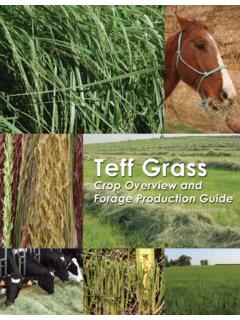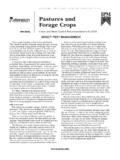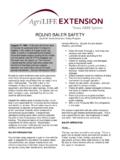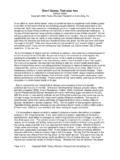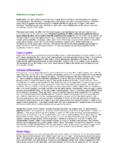Transcription of Feeding Longhorn Cattle
1 Feeding Longhorn Cattle On the assumption that health & welfare issues have been satisfactorily addressed, performance of beef Cattle is then determined by breeding and Feeding . Breeding will confer limits on conformation and growth rates but correct Feeding throughout the animal s life is vital to make the most of the genetic potential available. Live weight gain starts slowly in the life of the animal then speeds up and slows again as the animal matures, bone achieving its maximum growth rate first, followed by muscle, then fat. The later maturing Longhorn breed will not run to fat as readily as earlier maturing breeds such as Hereford or Angus.
2 Cattle fed on a lower plane of nutrition, to save money when housed through the winter (store Cattle ), grow especially fast when full Feeding is resumed at pasture in the summer. This compensatory growth is an evolutionary trait that allows animals to adapt to seasonal variations in feed supply. The following guidelines are designed to give a very approximate feel for the nutrition of the Longhorn . Information more specific to any given herd should be obtained from a qualified nutritionist. Feed sources As a rule of thumb, Cattle will consume approximately % of their live weight, in Dry Matter, per day.
3 A 600 kg cow will therefore eat 15 kilos of dry matter/day This equates to 50 kilos of 30% Dry Matter silage or 17 kilos of 86% Dry Matter hay. Inclusion of concentrate feed in the ration will reduce forage intake accordingly. 1. Forage Pasture The greatest part of the Longhorn s life will usually be spent grazing and one attribute of the breed is its ability to thrive on a great diversity of pasture, ranging from the best rye-grass and clover leys to coarser and more environmentally sensitive pastures, although the better the diet, the better the performance. After giving thought to stocking rates Cattle should be turned onto pasture in the Spring as soon as there is sufficient growth and the ground is dry enough to avoid poaching, especially in the case of unimproved and environmentally sensitive pastures, and removed in the Autumn before the pasture becomes damaged.
4 Hay Traditionally, the most common form of conserved forage and when cut early and made well it is a joy to behold and Cattle love it. However in the British climate hay making can be a lottery and potentially a great disappointment. Following late cutting after wild flowers have seeded, it may well be the preferred method of fodder conservation on species rich meadow land. As with all other winter fodders it should be kept fresh in front of the animals, fed little and often, on a daily basis where possible, although this will be extended when using ring feeders etc. Silage In its various forms this must be the best bet for conserving grass and associated mixes.
5 There is a method to suit most farms, whether it be clamp silage which can be utilised on a self feed basis where winter fodder handling is a problem, or wrapped round or square big bales - (wrapped small bales can be man handled). Ensiling grass is far less weather dependant than hay making and with a little help from the Met Office a well wilted product is often achievable and there should be no reason for a failure. Cutting at the optimum time when the grass is still young, it is possible to achieve a product with protein levels of up to 16% and an ME of 11 mega joules/kg in the dry matter. Straw Straw is a low protein and low energy forage.
6 For growing Cattle it will need supplementing with energy often supplied in the form of cereals or Sugar beet Pulp. To enhance the protein level, it is possible to use Soya, Rapeseed meal, Beans, Peas or other protein rich feeds. It is also possible to use Urea as a source of protein and this has the benefit of increasing the availability of the energy that is within the fibre of the straw. Bales of straw can be treated with urea by specialist contractors to enhance Feeding value. An alternative supplement to straw is a proprietary compound feed formulated to balance straw as the principal forage.
7 2. Concentrated feeds An attribute of the Longhorn is a low reliance on concentrate Feeding . However, appropriate concentrate Feeding of young stock and finishers can produce an excellent response. Grains must be rolled for Cattle (in preference to being ground, so that the energy is released over a longer period of time) and mixed with a protein balancer, where required, if a complete compound is not being used. Concentrates can be readily purchased as a complete feed, which will provide balanced energy and protein sources together with the required levels of vitamins and minerals.
8 An alternative route is to home mix the concentrates from cereals and, either a protein concentrate, or a protein rich feed such as Soya, Rapeseed meal or Beans or Peas. Of the usual home grown cereals, Barley is the traditional ingredient of choice for beef Feeding . It is possible to use Wheat but ideally at no more than 25% of the cereal fraction. Oats are lower in energy than Wheat or Barley and have a higher fibre content. This means that the energy supply that they release is slower acting. The pulses, Peas and Beans, can provide an excellent portion of the concentrate part of the diet.
9 They should again be rolled prior to Feeding . They both have protein levels of over 20% typically and when mixed with cereals or Sugar beet Pulp can form a balanced diet. Due to tannins in the husk of Beans in particular it is not advisable for them to exceed 20% of the total concentrates fed on a daily basis. It will be necessary to add vitamins and minerals to home mix rations, following specialist advice. In order to comply with existing legislation it is necessary to obtain a home mixing license, which can be applied for at the local Trading Standards office. 3. Vitamins/Minerals It is essential to know the limitations of forage, regarding mineral levels and these can be ascertained from blood samples and plant tissue analysis (with input from the vet and nutritionist) or more simply from local knowledge.
10 Mineral and vitamin supplementation either in feed, by free access or by bolus can then be given accordingly, to correct any deficiencies. Supplementation may only be necessary in certain categories of stock, especially breeding females to maintain fertility and when under pressure while requirements of various livestock categories The information given below is only a guide and should be adapted to individual situations Livestock Category Target Typical Feeding Options At Pasture Spring, Summer, Autumn Housed/Out-wintered In-Calf Cow/Heifer An animal fit, but not over fat at calving to reduce incidence of calving problems.
